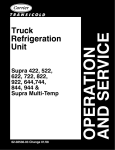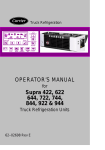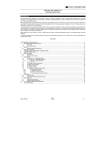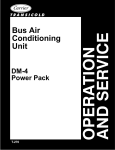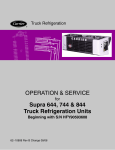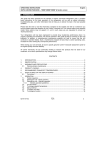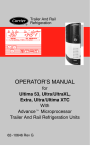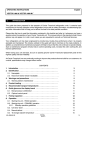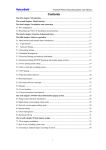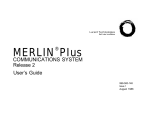Download Carrier Supra 650 Operator`s manual
Transcript
OPERATOR’S MANUAL Supra 550, 650, 750, 850 & 950 TRUCK REFRIGERATION UNITS CONTENTS Page Unit Identification . . . . . . . . . . . . . . . . . . . . . . . . . . 2 Safety . . . . . . . . . . . . . . . . . . . . . . . . . . . . . . . . . . . . 3 Pre-Trip Inspection . . . . . . . . . . . . . . . . . . . . . . . . . 4 Unit Operation . . . . . . . . . . . . . . . . . . . . . . . . . . . . 6 Starting the Unit -- Road Operation . . . . . . . . . . . 6 Starting the Unit -- Standby Operation . . . . . . . . 7 Starting the Unit -- Manual Operation . . . . . . . . . 8 Pretrip Check . . . . . . . . . . . . . . . . . . . . . . . . . . . . . 9 Changing Setpoint . . . . . . . . . . . . . . . . . . . . . . . . 10 Start/Stop Operation . . . . . . . . . . . . . . . . . . . . . . 12 Continuous Run Operation . . . . . . . . . . . . . . . . . 14 Manual Defrost . . . . . . . . . . . . . . . . . . . . . . . . . . . 15 City Speed . . . . . . . . . . . . . . . . . . . . . . . . . . . . . . . 16 Function Change . . . . . . . . . . . . . . . . . . . . . . . . . 17 Unit Data . . . . . . . . . . . . . . . . . . . . . . . . . . . . . . . . 19 Alarm Display and Reset . . . . . . . . . . . . . . . . . . 21 Stopping Unit . . . . . . . . . . . . . . . . . . . . . . . . . . . . 23 Product Loading . . . . . . . . . . . . . . . . . . . . . . . . . . 24 Recommended Transport Temperatures . . . . . 26 Problems . . . . . . . . . . . . . . . . . . . . . . . . . . . . . . . . 27 Troubleshooting . . . . . . . . . . . . . . . . . . . . . . . . . . 28 Relay Board . . . . . . . . . . . . . . . . . . . . . . . . . . . . . 30 Unit Maintenance . . . . . . . . . . . . . . . . . . . . . . . . . 32 Unit Maintenance Schedule . . . . . . . . . . . . . . . . 34 Standby Operation Guidelines . . . . . . . . . . . . . . 39 Emergency Road Service . . . . . . . . . . . . . . . . . . 40 SUPRA OPERATOR’S MANUAL This guide has been prepared for the operator of Carrier Transicold diesel truck refrigeration units. It contains basic instructions for the daily operation of the refrigeration unit as well as safety information, troubleshooting tips, and other information that will help you to deliver the load in the best possible condition. Please take the time to read the information contained in this booklet and refer to it whenever you have a question about the operation of your Carrier Transicold Supra unit. Your refrigeration unit has been engineered to provide long, trouble-free performance when it is properly operated and maintained. The checks outlined in this guide will help to minimize overthe-road problems. In addition, a comprehensive maintenance program will help to insure that the unit continues to operate reliably. Such a maintenance program will also help to control operating costs, increase the unit’s working life, and improve performance. This guide is intended as an introduction to your unit and to provide general assistance when needed. More comprehensive information can be found in the Operation and Service Manual for your unit. This manual can be obtained from your local Carrier Transicold dealer. When having your unit serviced, be sure to specify genuine Carrier Transicold replacement parts for the highest quality and best reliability. At Carrier Transicold, we are continually working to improve the products that we build for our customers. As a result, unit specifications may change without notice. 1 UNIT IDENTIFICATION Each Supra 50 Series unit is identified by a nameplate attached to the frame near the accumulator. This nameplate identifies the complete model number of the unit, the serial number, the refrigerant charge and quantity, and the date the unit was placed in service. If a problem occurs, please refer to the information on this plate, and make a note of the model and serial number before calling for assistance. This information will be needed when you contact a technician or Carrier Transicold Service Engineer so that he or she may properly assist you. NAMEPLATE 2 SAFETY Your Carrier Transicold refrigeration unit has been designed with the safety of the operator in mind. During normal operation, all moving parts are fully guarded to help prevent injury. During all pre-trip inspections, daily inspections, and problem troubleshooting, you may be exposed to moving parts; please stay clear of all moving parts when the unit is in operation and when the unit main power switch is in the RUN position. AUTO-START/STOP Your refrigeration unit is equipped with Auto-Start/Stop, a valuable fuel saving feature. When the unit is set for Auto-Start/Stop operation it may start at any time and without warning. When performing any check of the refrigeration unit (e.g., checking the belts, checking the oil), make certain that the main power switch is in the OFF position. ENGINE COOLANT The engine is equipped with a pressurized cooling system. Under normal operating conditions, the coolant in the engine and radiator is under high pressure and is very hot. Contact with hot coolant can cause severe burns. Do not remove the cap from a hot radiator. If the cap must be removed, do so very slowly in order to release the pressure without spray. REFRIGERANTS The refrigerant contained in the refrigeration system of your unit can cause frostbite, severe burns, or blindness when in direct contact with the skin or eyes. For this reason, and because of legislation regarding the handling of refrigerants during system service, we recommend that whenever your unit requires service of the refrigeration system, you contact your nearest Carrier Transicold authorized repair facility for service. BATTERY This unit utilizes a lead-acid type battery. The battery normally vents small amounts of flammable hydrogen gas. Do not smoke when checking the battery. A battery explosion can cause serious physical harm and/or blindness. 3 PRE-TRIP INSPECTION The pre-trip inspection should be performed before picking up any load. This inspection is essential to anticipate and help minimize the possibility of “over-the-road” problems. These checks take only a few minutes. 1. Place the unit’s main switch in the STOP (0) position. 2. Fuel -- drain any water and impurities from the sump of the refrigeration unit fuel tank by opening the drain-cock located on the bottom of the tank (if so equipped). Close the valve when only pure fuel emerges. Check the fuel level in the tank, ensuring that the fuel supply is adequate for unit operation. Refuel if necessary. 3. Belts -- Check the belt tension by depressing the belt with your thumb, near the center of the longest free run of each belt. Under moderate pressure each belt should deflect approximately 6 mm to 13mm (1/4 inch to 1/2 inch). If the belts deflect more than this they should be tightened (loose belts may slip, generating heat and reducing belt life). If the belts are too tight they should be loosened; tight belts can reduce bearing life. 3. Battery -- on units equipped with serviceable batteries, the level of the electrolyte in each of the cells should be checked. If the level is low, distilled water should be added to the correct level. Most units, however, are equipped with low or no--maintenance batteries. These should be inspected to ensure that the connections are clean and tight, and the battery hold--down should be checked for tightness. 4 5. Engine Oil -- the engine oil should be checked last since it is necessary for oil to drain from the block and into the oil pan to obtain a correct reading. Remove the dipstick, wipe it off and re-insert it fully into the engine block. Once again, remove the dip-stick and observe the oil level; it should be somewhere between the full and add marks. If it is below the add mark, add oil until the level is correct. MARKS ONLY NO WORDING 6. Over-all Unit -- visually inspect the entire unit for leaks, loose bolts, frayed, loose, or broken wires, etc. The radiator and condenser coils of the unit should be free of dirt, bugs, cardboard, or any other debris that may obstruct airflow across the coils. The evaporator (located inside the body) should be free of debris also, especially stretch-wrap, which is often used during transport to prevent cargo shifting. 7. Truck body -- The body should be inspected prior to loading. Check the door and vent seals for damage and wear. Inspect the entire interior and exterior of the body for damage; check for damage to the inner and outer skins of the body. Damage to the insulation may compromise the unit’s ability to maintain the product temperature by increasing the amount of heat gain across the truck body. 5 UNIT OPERATION STARTING THE UNIT -- ROAD OPERATION WARNING Under no circumstances should ether or any other starting aids be used to start engine. ALARM/FAULT -20 SETPOINT i 35° F UNIT DATA BOX TEMPERATURE FUNCTION ENTER AUTO START/STOP PRETRIP O I ROAD CITY SPEED MAN DEFROST BUZZER OFF STANDBY 1. Place the I/O switch in the “I” position. 2. If unit was previously used in Standby Mode, press the ROAD key. Under normal circumstances this is all that is required to start the unit. The unit will then perform a complete diagnostic check on the microprocessor controller, pre-heat for the required amount of time based on the engine temperature and start automatically. Complete the Pre-Trip Inspection described in the previous section. 6 STARTING THE UNIT -- STANDBY OPERATION WARNING Make sure the power plug is clean and dry before connecting to any power source. Do not attempt to connect or remove power plug or perform service and/or maintenance before ensuring the unit RUN/STOP Switch is in the STOP position and the I/O switch is in the “O” position. ALARM/FAULT -20 SETPOINT i 35° F UNIT DATA BOX TEMPERATURE FUNCTION ENTER AUTO START/STOP PRETRIP O I ROAD CITY SPEED MAN DEFROST BUZZER OFF STANDBY 1. Place the unit RUN/STOP switch in the “STOP” position and the I/O switch in the “O” position. 2. Connect unit to appropriate power source. (See table on page 39) 3. Place the unit RUN/STOP switch in the “RUN” position and the I/O switch in the “I” position. 4. Press Standby key. Under normal circumstances this is all that is required to run the unit in standby power. The unit will then perform a complete diagnostic check on the microprocessor controller and start automatically. Complete the Pre-Trip Inspection described in the previous section. 7 STARTING THE UNIT -- MANUAL OPERATION 1. Place unit RUN/STOP switch in RUN and I/O switch in “I” position. (Manual Operation will only function if unit is in Continuous Mode. If AUTO START/STOP indictor is illuminated, press AUTO START/STOP toggle key to place unit in Continuous Mode.) 2. Press FUNCTION key until AUTO OP or MAN OP is displayed. If MAN OP appears, unit is already in Manual Start Mode. ALARM/FAULT i MAN OP SETPOINT UNIT DATA BOX TEMPERATURE FUNCTION ENTER AUTO START/STOP PRETRIP O I ROAD CITY SPEED MAN DEFROST BUZZER OFF 3. If AUTO OP appears, first press ENTER key, then UP or DOWN arrow key until MAN OP appears. Press ENTER key to lock in Manual Mode. 4. Place manual GLOW/CRANK switch in GLOW and hold for 5 to 15 seconds. Then place switch in CRANK position to crank and start. Control Box 8 STANDBY PRETRIP CHECK 1. Start and run unit until box temperature is 40_±5°F (4.4_±2.8°C). 2. Press PRETRIP CHECK key. ALARM/FAULT i PPPP SETPOINT UNIT DATA BOX TEMPERATURE FUNCTION ENTER AUTO START/STOP PRETRIP O I ROAD CITY SPEED MAN DEFROST BUZZER OFF STANDBY The PRETRIP key initiates a check of all normal operating modes. Upon initiation, the unit will cycle through all operating modes at 30 second intervals. The display will show “PPPP” at the beginning and will show various unit data during the pre-trip cycle. The final PRETRIP mode is Defrost. When Defrost ends, PRETRIP will be complete. This is not a self-diagnosing pretrip test. No specific pretrip alarms will be generated. Pretrip must be monitored by the user to verify that the unit operates through all cycles. 9 CHANGING SETPOINT Press UP or DOWN arrow key to increase or decrease displayed setpoint. ALARM/FAULT -20 SETPOINT i 35° F UNIT DATA BOX TEMPERATURE FUNCTION ENTER AUTO START/STOP PRETRIP O I ROAD CITY SPEED MAN DEFROST BUZZER OFF STANDBY Press ENTER key when desired setpoint is displayed to lock in new setpoint. New setpoint will flash and then return to original setpoint if ENTER key is not pressed within 5 seconds. 10 Setpoints of -22°F to +89°F (-30°C to +32°C) may be entered via the keypad. The controller always retains the last entered setpoint in memory. If no setpoint is in memory (i.e. on initial startup), the controller will lock out the run relay and flash “SP” on the left hand display until a valid setpoint is entered. The setpoint may be changed up or down in 1° increments by pressing and releasing either the UP ARROW or DOWN ARROW key. You cannot change setpoint when unit is in Pretrip or when viewing Unit Data or Functional Parameters. 11 START/STOP OPERATION ALARM/FAULT -20 SETPOINT i 35° F UNIT DATA BOX TEMPERATURE FUNCTION ENTER AUTO START/STOP PRETRIP O I ROAD CITY SPEED MAN DEFROST BUZZER OFF STANDBY 1. Check if AUTO START/STOP indicator is illuminated. If not, press AUTO START/STOP toggle key to place unit in Start/Stop mode. AUTO START/STOP will then be illuminated. The AUTO START/STOP key is used to change the operating mode from “Continuous Run” to “Auto Start/Stop.” Each push of the key will alternate the operating modes. The Auto Start/Stop indicator on the display will illuminate when Auto Stop/Start is enabled. If the indicator is not illuminated, the unit is in the Continuous Run Mode. Automatic start/stop is provided to permit starting/restarting of the diesel-driven compressor as required. This gives the microprocessor automatic control of starting and stopping the diesel engine. The main function of automatic start-stop is to turn off the refrigeration system near the setpoint to provide a fuel efficient temperature control system and then restart the engine when needed. Start-Stop operation is normally used for frozen loads. Refer to RECOMMENDED TRANSPORT TEMPERATURES (See Page 26). 12 Whenever the unit starts in Auto Start--Stop, it will run until: SIt has run for the predetermined minimum run time. SThe engine coolant temperature is above 122°F (50°C) SThe box temperature is at setpoint. The controller will not shut off the engine if the battery voltage is not sufficient to restart it. Battery voltage above approximately 13.4 volts is required for shutdown. This varies depending on ambient. Look at battery voltage in data list to find out whether shutdown voltage has been reached. If there is a “+” in front of the number, the voltage is enough to shutdown and restart. If only the number appears, the voltage is still too low for shutdown. The controller will restart the engine if any of the following criteria have been met: SBox temperature has changed by ¦ 11°F (¦ 6.1°C)for setpoints in the perishable range and +11° F (+6.1°C) for setpoints in the frozen range DURING minimum off time. SBox temperature has moved away from setpoint by ¦3.6°F (2.0°C) AFTER minimum off time for setpoints in the perishable range or +0.5°F (0.3°C) for setpoints in the frozen range. SThe battery voltage drops below 12.2 Vdc Refer to Page 19 for unit data). SThe engine coolant temperature drops below 34°F (1°C). To start the unit in manual start mode, the unit must be in continuous run mode and the Auto/Manual Start Operation function parameter set to “MAN OP” (FN10 OFF) NOTE When configuration CNF11 is “ON” and setpoint is 32 to 42_ F (0 to 5.5_C) the unit is locked into continuous run. The AUTO START/STOP key is disabled. NOTE Auto Start-Stop operation may be tied to the setpoint ranges for frozen and perishable loads and the AUTO START/STOP key may be locked out. 13 CONTINUOUS RUN OPERATION ALARM/FAULT -20 SETPOINT i 35° F UNIT DATA BOX TEMPERATURE FUNCTION ENTER AUTO START/STOP PRETRIP O I ROAD CITY SPEED MAN DEFROST BUZZER OFF STANDBY 1. Check if AUTO START/STOP indicator is illuminated. If it is, press AUTO START/STOP toggle key to place unit in Continuous Run mode. AUTO START/STOP indicator will not be illuminated. In the Continuous Run mode, the diesel engine will run continuously providing constant air flow and temperature control to the product. Continuous Run operation is normally used for perishable loads. Refer to RECOMMENDED TRANSPORT TEMPERATURES (See Page 26). Continuous operation may be tied to the setpoint ranges for frozen and perishable loads and the AUTO START/STOP key may be locked out. 14 MANUAL DEFROST ALARM/FAULT -20 SETPOINT i 35° F UNIT DATA BOX TEMPERATURE FUNCTION ENTER AUTO START/STOP PRETRIP O I ROAD CITY SPEED MAN DEFROST BUZZER OFF STANDBY 1. Check that box temperature is 40_F (4.4_C) or lower. 2. Press MANUAL DEFROST key to initiate manual defrost. The defrost mode may be initiated in three different ways if the evaporator coil is below 40°F (4.4°C): 1. Defrost is initiated automatically at preset intervals by the defrost timer in the microprocessor. 2. Defrost is initiated by the defrost air switch. 3. The defrost mode may be manually initiated by pressing the Manual Defrost Key. The defrost mode terminates when the evaporator temperature is higher than 55°F (12.8°C). Should the defrost cycle not complete within 45 minutes, the defrost cycle is terminated automatically by the microprocessor. After the 45 minute termination, the controller will wait 1.5 hours before attempting another defrost cycle. Pressing the manual defrost key will override this mode and start a defrost cycle. If a shutdown alarm occurs, defrost will be terminated. 15 CITY SPEED ALARM/FAULT -20 SETPOINT i 35° F UNIT DATA BOX TEMPERATURE FUNCTION ENTER AUTO START/STOP PRETRIP O I ROAD CITY SPEED MAN DEFROST BUZZER OFF STANDBY 1. Press the CITY SPEED key to toggle between low speed only and normal operating mode. The CITY SPEED key enables the city speed mode of operation. In the city speed mode, the unit will operate in low speed. Each push of the key toggles the operating mode. The city speed indicator on the display will illuminate when the city speed mode is enabled. 16 FUNCTION CHANGE 1. Press FUNCTION key until Function to be changed is displayed. 2. Press ENTER key. ALARM/FAULT i DEFR 12.0H SETPOINT UNIT DATA BOX TEMPERATURE FUNCTION ENTER AUTO START/STOP PRETRIP O I ROAD CITY SPEED MAN DEFROST BUZZER OFF STANDBY 3. Press either UP or DOWN ARROW key until desired Function setting is displayed. NOTE: Function changes will change operation of unit. NOTE: If configuration CNF11 is “ON” functional parameters are locked. The ability to change any functional parameters is disabled. The Function Parameters control selected operating features of the unit. When multiple choices are available, the display will show the function description on the left side with the corresponding function choice on the right side. With a function parameter displayed, the data choice can be changed by pressing ENTER then pressing either the up or down ARROW keys. The displayed choice will then flash to indicate that the choice has not been entered. Depress the ENTER key to activate the new choice. The display will stop flashing to indicate that the choice has been entered. 17 FUNCTION CHANGE The following table has columns for Code and English displays. English is the default setting. Change Functional Parameter to Code to see Code display format. Functional Parameters CODE FN0 ENGLISH DEFR DATA Defrost Interval FN1 ON CITY SPD Low Speed FN1 OFF HIGH SPD High Speed FN2 OFF T Minimum Off-time FN3 ON T On-time FN4 a REM PROBE Controlling Probe -Return Air FN4 b SUP PROBE Controlling Probe -Supply Air FN5 Degrees F or C Temperature Unit _C or _F FN6 ON TIME STRT Maximum Off-time 30 Min. FN6 OFF TEMP STRT Temperature Based Restarting FN7 MOP STD Unloader Control FN8 2SET N/A FN9 3SET N/A FN10 ON AUTO OP Auto Start Operation FN10 OFF MAN OP FN11 T RANGE Out-of-Range Tolerance Manual Start Operation Code vs English = Code or English display format Manual Glow Override = Normal or Add 30sec Alarm RST = Alarm Reset Required Alarm CLR = No Alarm Active 18 UNIT DATA 1. Press UNIT DATA key to scroll thru data list one item at a time. ALARM/FAULT suct SETPOINT i 25P UNIT DATA BOX TEMPERATURE FUNCTION ENTER AUTO START/STOP PRETRIP O I ROAD CITY SPEED MAN DEFROST BUZZER OFF STANDBY 2. To scroll through the list faster, use the UP or DOWN ARROW keys. 3. Data will display for 5 seconds 4. Press the ENTER key to display data for 30 seconds. 5. The display will revert back to the default display if no keys are pressed for 5 seconds. The UNIT DATA key can be used to display the microprocessor input data values. The display will show the description of the input on the left side with the actual data on the right side. 19 UNIT DATA CODES The following table has columns for Code and English displays. English is the default setting. Change Functional Parameter to Code to see Code display format. ENGLISH DATA CODE CD1 SUCT Suction Pressure CD2 ENG Engine Hours CD3 WT Engine Temperature CD4 RAS Return Air Temperature *CD5 SAS Supply Air Temperature *CD6 REM Remote Air Temperature CD7 ATS Ambient Temperature CD8 EVP Future Expansion CD9 CDT Discharge Temperature CD10 BATT Battery Voltage CD11 SBY Standby Hours CD12 MOD V Future Expansion CD13 REV Software Revision CD14 SERL Serial Number Low CD15 SERU Serial Number Upper CD16 2RA N/A CD17 3RA N/A CD18 MHR1 Maintenance Hour Meter 1 CD19 MHR2 Maintenance Hour Meter 2 CD20 SON Switch On Hour Meter * Codes 5 & 6 are variable. SAS is displayed when the SUP Probe Function is selected. REM is displayed when the REM Probe Function is selected. 20 ALARM DISPLAY & RESET ALARM DISPLAY When fault light is on, normal display of Setpoint /Box temperature alternates with alarm display. Check display for alarm message. ALARM RESET FAULT LIGHT ALARM/FAULT i ENG OIL SETPOINT UNIT DATA BOX TEMPERATURE FUNCTION ENTER AUTO START/STOP PRETRIP O I ROAD CITY SPEED MAN DEFROST BUZZER OFF STANDBY 2. Press UP/DOWN arrow key until ALARM RST is displayed. 3. Press ENTER to clear alarm. ALARM CLR will be displayed. (Unit will restart if alarm condition has been corrected and unit is in Start/Stop or Auto OP). ALTERNATE ALARM RESET Place I/O switch in “O” position. (Unit can now be restarted after alarm condition has been corrected). 21 Table 2-1. Alarm Display The following table has columns for Code and English displays. English is the default setting. Change Functional Parameter to Code to see Code display format. ALARM DISPLAY ENGLISH CODE = FAULT LIGHT ON DESCRIPTION AL0 ENG OIL AL1 ENG HOT AL2 HI PRESS AL3 STARTFAIL AL4 LOW BATT AL5 HI BATT AL6 DEFR FAIL AL7 ALT AUX AL8 STARTER AL9 RA SENSOR AL10 SA SENSOR Supply Air Sensor Fault AL11 WT SENSOR Coolant Temperature Sensor AL12 HIGH CDT AL13 CD SENSOR AL14 SBY MOTOR AL15 FUSE BAD AL17 DISPLAY Display AL18 SERVICE 1 Maintenance Hour Meter 1 AL19 SERVICE 2 Maintenance Hour Meter 2 AL20 RAS OUT Low Oil Pressure High Coolant Temperature High Discharge Pressure Auto Start Failure Low Battery Voltage High Battery Voltage Defrost Override No Alternator Auxiliary Output Starter Motor Fault Return Air Sensor Fault High Discharge Temperature Discharge Temperature Sensor Fault Standby Motor Fault Fuse Open AL16 SYSTEM CK Check Refrigeration System Main Compartment Out--of-Range AL21 2RA OUT AL22 3RA OUT AL23 NO POWER N/A N/A No AC Power When Unit Is In Standby 22 STOPPING UNIT ALARM/FAULT -20 SETPOINT i 35° F UNIT DATA BOX TEMPERATURE FUNCTION ENTER AUTO START/STOP PRETRIP O I ROAD CITY SPEED MAN DEFROST BUZZER OFF STANDBY 1. To stop the unit, place the I/O switch in the “O” position. The diesel engine/electric motor will stop and the microprocessor controller will turn off. 23 PRODUCT LOADING BEFORE LOADING: D Pre-cool the body. This will remove much of the heat from the inside of the body, and give the product better protection when it is loaded. D Place the unit in a defrost cycle immediately before loading. This will remove moisture accumulated on the evaporator coil. DURING LOADING: D Turn the unit off! D Check product temperature during loading. D Ensure that the air return and supply opening remain unobstructed. D Leave approximately 4 to 5 inches between the load and the front wall for air return to the unit. D Leave at least 10 to 12 inches between the top of the load and the ceiling to ensure that there is nothing to prevent airflow to the rear of the body D Load product on pallets to provide free air return to unit and improve product protection. Proper air circulation in the truck body -- air that can move around and through the load -- is a critical element in maintaining product quality during transport. If air cannot circulate completely around the load, hot spots or top-freeze can occur. The use of pallets is highly recommended. Pallets, when loaded so air can flow freely through the pallets to return to the evaporator, help protect the product from heat that passes through the floor of the trailer. When using pallets, it is important to refrain from stacking extra boxes on the floor at the rear of the trailer. This will cut off the airflow. 24 Product stacking is another important factor in protecting the product. Products that generate heat -- fruits and vegetables, for example -- should be stacked so the air can flow through the product to remove the heat. This is called “air stacking” the product. Products that do not create heat -- meats and frozen products -should be stacked tightly in the center of the trailer. All products should be kept away from the side-walls of the body, to allow air flow between the body and the load; this prevents heat filtering through the walls from affecting the product. It is important to check the temperature of the product being loaded to ensure that it is at the correct temperature for transport. The refrigeration unit is designed to maintain the temperature of the product at the temperature at which it was loaded. It was not designed to cool warm product. 25 RECOMMENDED TRANSPORT TEMPERATURES Below are some general recommendations on product transport temperatures and operating modes for the unit. These are included for reference only and should not be considered preemptive of the set point required by the shipper or receiver. More detailed information can be obtained from your Carrier Transicold dealer. Product Setpoint Range Operating Mode* _F _C Bananas 56 to 58 13 to 14 Continuous Fresh fruits and vegetables 33 to 38 0.5 to 3 Continuous Fresh meats and seafood 28 to 32 --2 to 0 Auto-Start/Stop or Continuous Dairy Products 33 to 38 0.5 to 3 Auto-Start/Stop or Continuous Ice 15 to 20 --10 to --7 Auto-Start/Stop** Frozen fruits and vegetables --10 to 0 --23 to --18 Auto-Start/Stop** Frozen meats and seafood --10 to 0 --23 to --18 Auto-Start/Stop** --20 to --15 --29 to --26 Auto-Start/Stop** Ice Cream * During delivery cycles that include frequent stops and door openings, it is recommended that the unit always be operated in the continuous run mode to help ensure product quality. If it is possible, the unit should be turned off during the time the body doors are open to help preserve the product temperature. **Variations may be necessary for very high or very low ambient temperatures. 1. 26 PROBLEMS Everything possible has been done to ensure that your unit is the most reliable, trouble-free equipment available today. If, however, you run into problems the following section may be of assistance. If you do not find the trouble that you have experienced listed, please call your Carrier Transicold dealer for assistance. General Problems Unit won’t crank. Check battery condition. Check battery connections. Check all fuses Unit won’t start. Check fuel level. Check all fuses Check fuel level. Check engine oil level. Check all fuses Unit won’t run. Unit stops running. Check belts. Check engine oil level. Check coolant level. Check fuel level. Check all fuses. Unit not cooling properly. Defrost unit. Check evaporator for airflow restriction. Check condenser for airflow restriction. Check body for damage or air leaks. Fault Display on Cab Command Service 1 Service 2 Unit is calling attention to a normal service requirement (oil change, etc.). Normally this does not require immediate attention. 27 TROUBLESHOOTING Fault Display on Cab Command AL0 ENG OIL AL1 ENG HOT AL2 HI PRESS AL3 STARTFAIL LOW BATT HI BATT AL4 AL5 AL6 AL7 AL8 AL9 AL10 AL11 AL12 AL13 AL14 AL15 DEFR FAIL ALT AUX Low engine oil pressure condition. Check engine oil level. The engine has overheated. Check the coolant level, belts, and radiator coil for air restriction. High compressor discharge pressure. Check all belts, check condenser coil for airflow obstruction and cleanliness The engine has failed to start. Check battery, fuses and fuel level. The battery voltage has fallen below 10 VDC. Check battery. The battery voltage is above 10 VDC. Check battery. The unit is in a defrost override mode. The alternator signal is not present with the engine running or with the standby electric mode active. Check alternator. STARTER The starter motor input signal is not present with the starter solenoid output on. Check starter solenoid. RA The return air sensor is not working and SENSOR the unit has shut down. Check probe. SA The supply air sensor has been chosen in SENSOR the functional parameters and is not working. WT The coolant temperature sensor is not SENSOR working. HIGH CDT The discharge temperature is above 310°F or 340°F if ambient temperature is above 120°F. CD The discharge sensor is not working. SENSOR SBY The standby motor is overloaded. MOTOR FUSE One of the fuses has low input. Check BAD fuses. 28 Fault Display on Cab Command AL16 SYS CK AL17 AL18 AL19 AL20 AL21 AL22 AL23 Low refrigerant pressure detected. Have system checked for leaks. DISPLAY Communication between main board and the display board has been interrupted. SERVICE Hour meter is greater than maintenance 1 hour meter 1. SERVICE Hour meter is greater than maintenance 2 hour meter 2. RAS OUT Box temperature is Out--of--Range. 2RA OUT Not Applicable 3RA OUT Not Applicable NO POWER No AC power when unit is in Standby. 29 RELAY BOARD The fuses and relays that protect the unit are located on the relay board in the control box on the roadside of the unit. They may be accessed by loosening the screws that hold the control panel closed. F1 F4 EFHR3 F2 F10 F7 F6 F9 F5 F11 F3 F8 30 Fuse Identification Fuse Purpose F1 F2 F3 F4 F5 F6 F7 F8 F9 F10 F11 Main Fuse RCR Fuse Run Relay Fuse Heat Relay Fuse Speed Relay Fuse Unloader Fuse (850 & 950) Defrost Damper Relay Fuse Evaporator Fan Motor 1 Fuse Evaporator Fan Motor 2 Fuse Evaporator Fan Motor 3 Fuse Fuel Pump Fuse Fuel Heater Fuse (on fuel adding harness) F12 Capacity (Amps) 80A 5A 15A 3A 10A 5A 15A 20A 20A 20A 5A 25A Relay Identification Desig. SSR EFMR1 EFMR2 EFMR3 DDR UFR CCR SR HR1 DER RR GPR RCR EHR Item Starter Solenoid Relay Electric Fan Motor Relay Electric Fan Motor Relay Electric Fan Motor Relay Defrost Damper Solenoid Relay (Option) Unloader Front Relay (850 & 950) Compressor Clutch Relay Speed Relay Heat Relay 1 Diesel Electric Relay Run Relay Glow Plug Relay Run Control Relay Evaporator Heater Relay 31 UNIT MAINTENANCE Engine oil -- the oils recommended for use in your refrigeration unit must comply with the American Petroleum Institute’s (API) SG/CD rating. The use of any oil that does not meet this rating may affect the warranty on the engine in the unit. The use of oil of the proper weight (viscosity) is also essential. The following chart indicates the SAE Weight Rating of the oil to be used in various climates: _F 30W or 15W40 20W or 15W40 10W or 10W30 _C The following oils are approved for use in the Supra range of units: In the US, Canada Mexico, Central and South America, any oil that meets the above API specification is suitable for use in the Supra range of units. Mobil Delvac1 is the only approved synthetic oil. 32 UNIT MAINTENANCE SCHEDULE For the most reliable operation and for maximum life, your unit requires regular maintenance. This includes oil and filter changes, fuel and air filter replacement, coolant replacement. Maintenance should be performed on the following schedule: SERVICE SCHEDULE FOR SUPRA 550 Petroleum and Synthetic OilWith and Without Bypass At 250 Hours D Check engine cooling system. D Check and clean the air filter. D Check all bolts, screws and unit mounting bolts for tightness. Tighten as required. D Check all belts. Petroleum Oil Without Bypass At 500 and every 500 hours after Petroleum OilWith Bypass At 600 and every 600 hours after Synthetic OilWithout Bypass At 1000 and every 1000 hours after Synthetic Oil With Bypass At 1200 and every 1200 hours after D Replace lube oil and filter. D Check engine cooling system. D Check and clean the air filter. D Check all belts. 33 SERVICE SCHEDULE FOR SUPRA 550 (CONT) Petroleum and Synthetic Oil With and Without Bypass At 1500 Hours D Check fuel pump filter. D Replace the cartridge of the dry air filter. D Check battery terminals and fluid level. D Check compressor oil level. Use polyol ester oil (POE) approved by CARRIER. D Check alternator brushes. Check for diesel and standby hours. D Check engine thermostat. D Check defrost: -- Check timer setting and function -- Check refrigerant control valves -- Fans stop or defrost damper closes -- Defrost ends automatically -- Water drains from evaporator D Check fan motor brushes. D Check and adjust rocker arms. D Check belts as necessary. Petroleum and Synthetic Oil With and Without Bypass At 2000 Hours D Replace oil filter. D Clean radiator/condenser coil. D Check refrigerant level. Petroleum and Synthetic Oil With and Without Bypass At 3000 Hours Petroleum and Synthetic Oil With and Without Bypass With Standard Coolant At 6000 Hours Petroleum and Synthetic Oil With and Without Bypass With Ext. Life At 12000 Hours D Change fan motor brushes. D Check and rebuild alternator. D Check engine speed: High -- 2300 to 2350 Low -- 1800 to 1850 D Check all belt tension pulleys D Change anti--freeze and flush cooling system. D Check bearings in clutch and electric motors. D Clean and adjust fuel injectors. D Check all belt tension pulleys D Change anti--freeze and flush cooling system. D Check bearings in clutch and electric motors. D Clean and adjust fuel injectors. 34 SERVICE SCHEDULE FOR SUPRA 650/750/850 Petroleum and Synthetic OilWith and Without Bypass At 250 Hours D Check engine cooling system. D Check and clean the air filter. D Check all bolts, screws and unit mounting bolts for tightness. Tighten as required. D Check all belts. Petroleum Oil Without Bypass At 750 and every 750 hours after Petroleum OilWith Bypass At 1000, 1500, 3000 Hours Synthetic OilWithout Bypass At 1500 and every 1500 hours after Synthetic Oil With Bypass At 2000 and every 2000 hours after D Replace lube oil and filter. D Check engine cooling system. D Check and clean the air filter. D Check all belts. Petroleum and Synthetic Oil With and Without Bypass At 1500 Hours D Check fuel pump filter. D Replace the cartridge of the dry air filter. D Check battery terminals and fluid level. D Check compressor oil level. Use polyol ester oil (POE) approved by CARRIER. D Check alternator brushes. Check for diesel and standby hours. D Check engine thermostat. D Check defrost: -- Check timer setting and function -- Check refrigerant control valves -- Fans stop or defrost damper closes -- Defrost ends automatically -- Water drains from evaporator D Check fan motor brushes. D Check and adjust rocker arms. D Check belts as necessary. 35 SERVICE SCHEDULE FOR SUPRA 650/750/850 (CONT) Petroleum and Synthetic Oil With and Without Bypass At 2000 Hours Petroleum and Synthetic Oil With and Without Bypass At 3000 Hours Petroleum and Synthetic Oil With and Without Bypass With Standard Coolant At 6000 Hours Petroleum and Synthetic Oil With and Without Bypass With Ext. Life At 12000 Hours D Replace oil filter. D Clean radiator/condenser coil. D Check refrigerant level. D Change fan motor brushes. D Check and rebuild alternator. D Check engine speed: High -- 2300 to 2350 Low -- 1800 to 1850 D Check all belt tension pulleys D Change anti--freeze and flush cooling system. D Check bearings in clutch and electric motors. D Clean and adjust fuel injectors. D Check all belt tension pulleys D Change anti--freeze and flush cooling system. D Check bearings in clutch and electric motors. D Clean and adjust fuel injectors. 36 SERVICE SCHEDULE FOR SUPRA 950 Petroleum and Synthetic OilWithout Bypass At 250 Hours D Check engine cooling system. D Check and clean the air filter. D Check all bolts, screws and unit mounting bolts for tightness. Tighten as required. D Check all belts. Petroleum Oil Without Bypass At 1000 and every 1000 hours after Synthetic OilWithout Bypass At 1500, 3000 and 4000 hours D Replace lube oil and filter. D Check engine cooling system. D Check and clean the air filter. D Check all belts. Petroleum and Synthetic Oil Without Bypass At 1500 Hours D Check fuel pump filter. D Replace the cartridge of the dry air filter. D Check battery terminals and fluid level. D Check compressor oil level. Use polyol ester oil (POE) approved by CARRIER. D Check alternator brushes. Check for diesel and standby hours. D Check engine thermostat. D Check defrost: -- Check timer setting and function -- Check refrigerant control valves -- Fans stop or defrost damper closes -- Defrost ends automatically -- Water drains from evaporator D Check fan motor brushes. D Check and adjust rocker arms. D Check belts as necessary. Petroleum and Synthetic Oil Without Bypass At 2000 Hours D Replace oil filter. D Clean radiator/condenser coil. D Check refrigerant level. Petroleum and Synthetic Oil Without Bypass At 3000 Hours D Change fan motor brushes. D Check and rebuild alternator. D Check engine speed: High -- 2300 to 2350 Low -- 1800 to 1850 37 SERVICE SCHEDULE FOR SUPRA 950 (CONT) Petroleum and Synthetic Oil Without Bypass With Standard Coolant At 6000 Hours D Check all belt tension pulleys D Change anti--freeze and flush cooling system. D Check bearings in clutch and electric motors. D Clean and adjust fuel injectors. Petroleum and Synthetic Oil Without Bypass With Ext. Life At 12000 Hours D Check all belt tension pulleys D Change anti--freeze and flush cooling system. D Check bearings in clutch and electric motors. D Clean and adjust fuel injectors. Supra 650/750/850 Petroleum 500 Hours* 750 Hours* W/Bypass 600 Hours* 1000 Hours* 1000 1500 Synthetic** Hours** Hours** W/Bypass 1200 Hours* 2000 Hours* Oil Type Supra 550 Supra 950 100 Hours* N/A 2000 Hours** N/A * Maximum oil drain interval is one year (12 months). ** Mobil Delvac1 is the only approved synthetic oil. Maximum oil drain interval is two (2) years. Oil filter change required once a year (every 12 months). These maintenance schedules are based on the use of approved oils and regular Pre-Trip inspections of the unit. Failure to follow the recommended maintenance schedule may affect the life and reliability of the refrigeration unit. In addition to the above service requirements please adhere to the following: D All units are shipped with Extended Life Coolant. Replace every 5 years/12,000 hours. A more detailed description of service requirements and procedures can be found in the Service and Operations Manual for your unit. This manual may be obtained from any Carrier Transicold dealer. 38 STANDBY OPERATION GUIDELINES For safe, reliable operation in Standby mode, it is important to follow a few guidelines: D Never plug the unit in to the power source with the main switch in the RUN (I) position. The main switch should always be in the STOP(O) position when connecting the unit to the power source. D The circuit breaker and extension cable used for Standby operation should conform to the following: D Operating Voltage FLA Rating Circuit Breaker Capacity Cable Requirement 208/230 V 60 hz 3 phase 15.8 A 50 A 8/3 with ground (up to 50 ft) 460 V 60 hz 3 phase 13.2 A 30 A 10/3 with ground (up to 75 ft) When multiple units are in use, each unit must be operated on its own electrical circuit. You should never operate more than one unit on a circuit breaker. Important note: This information is provided as a guideline only. When preparing a circuit for operation of the refrigeration unit, a licensed electrician should be contracted. A licensed electrician is familiar with all local ordinances and special requirements for your area and can ensure that the circuits are properly designed and installed, and that connections are correct. 39 EMERGENCY ROAD SERVICE At Carrier Transicold we’re working hard to give you complete service when and where you need it. That means a worldwide network of dealers that offer 24-hour emergency service. These service centers are manned by factory trained service personnel and backed by extensive parts inventories that will assure you of prompt repair. Should you experience a unit problem with your refrigeration unit during transit, follow your company’s emergency procedure or contact the nearest Carrier Transicold service center. Consult the Shortstop Service Centers directory to locate the service center nearest you. This directory may be obtained from your Carrier Transicold dealer. If you are unable to reach a service center, call our 24-hour Action Line: Call (800) 448-1661 from any phone in the United States or Canada. When calling, please have the following information ready for fastest service: S Your name, the name of your company, and your location. S A telephone number where you can be called back. S Refrigeration unit model number and serial number. S Box temperature, set point and product. S Brief description of the problem you are having, and what you have already done to correct the problem. We will do everything we can to get your problem taken care of and get you back on the road. 40 CALIFORNIA Proposition 65 Warning Diesel engine exhaust and some of its constituents are known to the State of California to cause cancer, birth defects,and other reproductive harm. North America Carrier Transicold 700 Olympic Drive Athens, GA 30601 USA Tel: 1--706--357--7223 Fax: 1--706--355--5435 Central America and Mexico Ejercito Nacional No. 418 Piso 9, Torre Yumal Col. Chapultepec Morales 11570 Mexico, D.F. Tel: (5255) 9126.0300 Fax: (5255) 9126.0373 Carrier Transicold Division, Carrier Corporation Truck/Trailer Products Group P.O. Box 4805 Syracuse, N.Y. 13221 U.S A www.carrier.transicold.com A member of the United Technologies Corporation family. Stock symbol UTX ©2006 Carrier Corporation D Printed in U. S. A. 0306













































